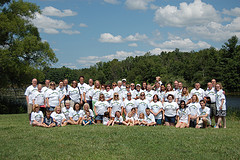Use a Reunion to Research Your Family History Book
Biff Barnes
If you are part of an extended family that gets together for summer reunions, big holiday gatherings, or to commemorate important occasions like 75th birthdays, 50th anniversaries, or retirements, then you are fortunate. These family gatherings are virtual gold mines for the would-be family or personal historian. Bringing together your relatives gives you eyewitness sources who can add information to whatever you are researching.
 Courtesy of the Mulvenna Family under Creative Commons
Courtesy of the Mulvenna Family under Creative Commons
There are some simple things that you can do to make sure that you take maximum advantage of the opportunity your family gathering will present. Begin by making a list of the people who will be in attendance you would most like to talk with. Contact them and let them know about the project you are working on and ask for their help in gathering family stories.
Before the reunion, develop a list of the topics you would like to include in your book. Develop specific questions about each of the topics. Your questions should be both factual and open ended. A question like, “What do you remember about holidays at Grandma’s house?” can trigger memories of things you hadn’t even thought about. Get copies of your list out to the people who have agreed to help, just to jog their memories.
When you get to the reunion, there are two ways to approach gathering information. Each has advantages and you may want to use both. One is to have a family story circle. Get people together and ask them to tell their favorite family stories. As they do, you may be surprised at how the memories of others in the circle elicit details of a story or trigger a whole new story. Make sure to get audio recordings or video to capture the stories people share.
 Courtesy of James Lee under Creative Commons
Courtesy of James Lee under Creative Commons
The second technique is to conduct an oral history interview with each of the relatives who have agreed to talk with you. (A good resource for conducting these interviews is available at Tips for Interviewers from the Regional Oral History Project at U.C. Berkeley.) Sit down with each person in a private setting with an audio or video recorder. Run through the list of questions you developed, but be ready to pursue interesting tangents to get more detail. The more you let people talk about what they remember, the more stories you will get. You may also find that different relatives remember the same events in quite different ways.
Another way to gather information at a family gathering is to organize a photo swap. (The photo swap requires some technical expertise. Recruiting a few young technical assistants from the family can speed the process.) Ask family members to bring old, historic, family pictures. Have them attach a sticky note to the back of the photo with the names of those pictured, the approximate date of the photo, if known, their own name and an ID number to identify each photo. Bring a scanner, a laptop computer and perhaps a CD burner. You can create a CD of everyone’s photos and distribute copies, and in exchange you will have gathered many illustrations for your book. (For a more complete discussion of this topic see How Stuff Works Family History Photo Swap.)
Family members can contribute to a memorabilia table by bringing treasured documents or artifacts. Encourage them to bring things from scrapbooks, old marriage certificates, school records, newspaper clippings, military decorations and family Bibles. Be sure that the items are carefully labeled and that the table is always hosted. Many of these items can be scanned, and if not, take a moment to snap a good digital picture. You may never have an opportunity to see these family treasures in their original form again, but the image in your book will be passed around for generations.
Taking the time to gather family history from relatives can greatly enrich the book you eventually produce. If you try these methods early in the book project, the valuable stories and images you collect may take you in a direction you would not have expected!